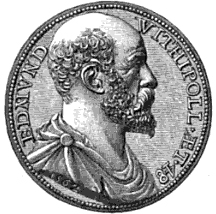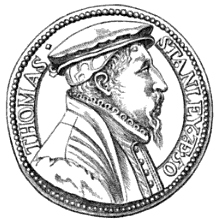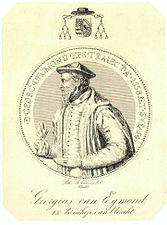Steven van Herwijck

Steven Cornelisz. van Herwijck (
Life
Van Herwijck worked in Italy in 1557 and returned to Utrecht in 1558, when he was made a Master of the artists' guild, then in fact the saddlemaker's guild, which Utrecht artists shared, rather than having their own

In 1562 he travelled to England, where he produced the first portrait medals of private individuals to be made in that country.
In 1564, van Herwijck was back in the Netherlands, spending time in both Utrecht and Antwerp. Antonis Mor's Portrait of a Goldsmith, identified as van Herwijck, is dated 1564 and it is likely that a portrait medallion of Mor by van Herwijck dates to this period.[2] The Mor portrait may mark van Herwijck's marriage; a portrait of his wife Jonekin by Mor of the same date is in the Hunterian Museum and Art Gallery in Glasgow.[7] Van Herwijck returned to London in 1565, where he struck a medal of
Identification
Stephen of Holland
Van Herwijk's medals are typically signed "Ste. H." or "Ste. H. F.", and the 18th century English engraver and
"The famous paynter Steven" ?
The 1590 inventory of the paintings in the collection of John Lumley, 1st Baron Lumley refers to a number of works dated to the early 1560s by "the famous paynter Steven". Sir Roy Strong and others identified this "Steven" with the Flemish artist Steven van der Meulen and suggested a body of works roughly dated 1560–1568.[4][12] The recent discovery of van der Meulen's will dated 1563 and proved in 1564 has raised questions about this traditional identification,[13] and in the Spring 2009 issue of The British Art Journal Bendor Grosvenor proposed an alternative identification of the painter "Steven" with van Herwijck.[4] This new identification was accepted by a number of institutions, such as Tate Britain and the V&A, who exhibited a portrait of Elizabeth I as attributed to van Herwijck. In her 2014 study of the portraiture and patronage of Robert Dudley, 1st Earl of Leicester, Elizabeth Goldring raises concerns with identification of van Herwijck with the "paynter Steven"[14] This identification is also rejected by Edward Town in his A Biographical Dictionary of London Painters, 1547–1625 (2014):
Although there is no denying that there were links between Steven van Herwijck and the Dymock family, this does not necessarily mean that van Herwijck was the 'Master Staffan' who travelled to Sweden in early 1561. In fact, the sequence of events that followed the Swedish embassy fits better with what we know of Steven van der Meulen's subsequent career in England than that of van Herwijck.[15]
Dendrochronological study of the portrait of John Lumley in the National Portrait Gallery reveals that the painting is correctly dated to the 1570s or 1580s, after the documented deaths of both van der Meulen and van Herwijck. Of the identification of the painter, the NPG says "The style of painting is consistent with an Anglo-Netherlandish artist from this period.... However, as both van der Meulen and van Herwijck died in the 1560s the artist responsible for NPG 5262 must remain as an as yet unidentified émigré".[16]
Works
-
Edmund Withipoll in a toga, 1562
-
Thomas Stanley (obverse), 1562
-
Thomas Stanley (reverse), with his coat of arms, 1562
-
Mid-19th century lithographic print after medal of George van Egmond, 1558.
Notes
- ^ a b c d e Grove Dictionary of Art (2002) "Steven van Herwijck"
- ^ a b "Steven van Herwijck". Retrieved 22 October 2009.
- ^ a b c Carson (2006), p. 326
- ^ a b c d Grosvenor (2009)
- High Sheriff of Norfolk and Suffolk in 1571, and knighted in 1601.[1] His father, Paul, was a "merchant tailor of London" [2]
- ^ Hawkins (1885), pp. 103–110
- ISSN 1388-9559. Retrieved 22 October 2009.
- ^ "Queen Elizabeth I by Steven van Herwijck". Retrieved 22 October 2009.
- ^ Hawkins (1885), p. 113.
- ^ Grosvenor (2009), p. 12
- ^ He is called "Steven of Holland" in Hawkins (1885).
- ^ Strong (1969) p. 119
- National Portrait Gallery web site accepts a date death of 1563–64. A 2007 Sotheby's auction catalogue gives the traditional dates of "active 1543–1568", but a condition report on Sotheby's website retrieved 29 March 2008notes "The correct dates for the artist are Fl.1543–1563."
- ^ See Goldring (2014), pages 321-322, notes 19, 20, and 21.
- JSTOR 24855803.
- ^ "John Lumley, 1st Baron Lumley (NPG5262)". Retrieved 3 November 2014.
References
- Carson, R. A. G (2006). Mints, Dies and Currency: Essays Dedicated to the Memory of Albert Baldwin. Routledge. ISBN 0-415-37865-6. Retrieved 22 October 2009.
- "Dutch and Flemish Art in Glasgow" (PDF). Courant (15). Codart. Winter 2008. ISSN 1388-9559. Retrieved 22 October 2009.
- Goldring, Elizabeth (2014). Painting and patronage at the Elizabethan court : Robert Dudley, Earl of Leicester, and his world. New Haven: Yale University Press. ISBN 9780300192247.
- Grosvenor, Bendor (Spring 2009). "The identity of 'the famous paynter Steven': Not Steven van der Meulen but Steven van Herwijck". The British Art Journal. IX (3): 12–17. ISSN 1467-2006. Retrieved 6 November 2023.
- "Steven van Herwijck". The Concise Grove Dictionary of Art. Oxford University Press, Inc. 2002. Retrieved 22 October 2009.
- Hawkins, Edward (1885). Augustus Wollaston Franks; Herbert Appold Grueber (eds.). Medallic illustrations of the history of Great Britain and Ireland to the death of George II. Vol. I. The British Museum. Retrieved 23 October 2009.
- "Steven van Herwijck". Retrieved 22 October 2009.
- Strong, Roy: The English Icon: Elizabethan and Jacobean Portraiture, 1969, Routledge & Kegan Paul, London
- Town, Edward (1 January 2014). "A Biographical Dictionary of London Painters, 1547–1625". The Volume of the Walpole Society. 76: 180. JSTOR 24855803.
External links
Photographs of surviving medals
- Wouter van Bijler by Steven van Herwijck, 1558
- Elizabeth Parr née Brooke, Marchioness of Northampton by Steven van Herwijck, 1562
- Queen Elizabeth I by Steven van Herwijck, 1565





